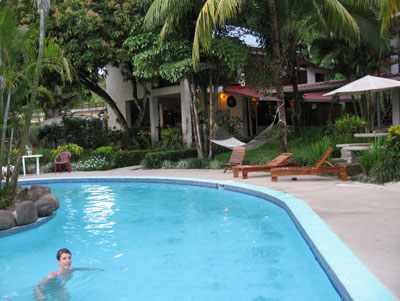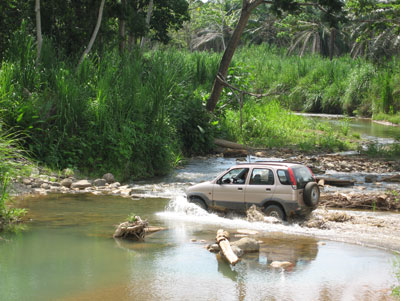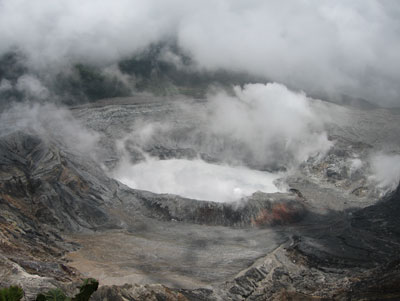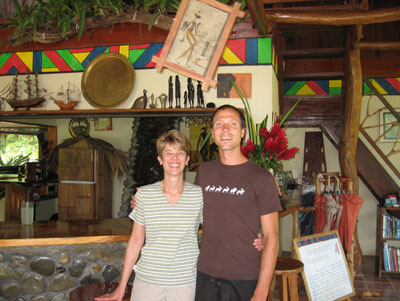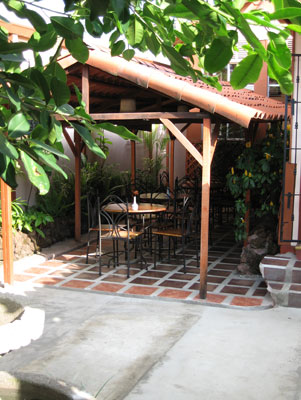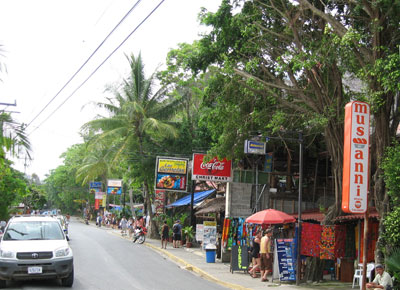Driving Costa Rica’s ‘infamous’ roads and highways
by Inga Aksamit, San Rafael, CA
“Are you going to go zip-lining?” everyone asked when told that my husband, Steve, and I were headed to Costa Rica for our next set of adventures.
It sounded like fun until so many people asked that I started envisioning the canopy of the jungle crisscrossed with zip-lines zinging tourists across the sky. We decided to head away from the popular tourist zones to find our adventures on the infamous roads of Costa Rica (infamous due to significant deferred maintenance).
Our informal research indicated that the most popular route is from the capital city, San José, to the west or northwest. Being independent travelers, we decided to rent a sturdy though diminutive 4-wheel-drive vehicle and instead head south, staying at modest inns along the way.
Alajuela
Upon arrival in the Aeropuerto Internacional Juan Santamaría, located 17 kilometers northwest of San José, we headed to Alajuela, the only place on our entire trip where we had made reservations. Alajuela is a small town located only three kilometers from the airport, making it more convenient to the airport than San José is, not to mention more attractive and relaxed.
Hotel Los Volcanes (Av. 2 between Calles Central and 2nd) was a bit challenging to find at 10 p.m. Searching for the address in the dark, we learned our first lesson about Costa Rica: there are very few street signs, and when they do exist they are small and randomly placed.
Luckily, the gentleman at the rental car agency had called the inn to get directions for us, but we still drove around and around until we happened upon it. We were very happy to find secured parking after navigating the narrow streets and alleys.
The inn turned out to be delightful, with moderately large, comfortable rooms ($35-$45) with high ceilings, free Internet access and a lovely breakfast served outdoors in a courtyard every morning.
In the morning we had our first exposure to the Costa Rican version of a hot shower; an electrical gizmo attached directly to the shower head supposedly warmed the water. We found these in every one of the inns we stayed in. Some were more effective than others, while the one with wires sticking out did not seem compatible with water. Thankfully, electrocution was avoided, but I was careful to never reach up while the water was running.
The town of Alajuela had a charming square that filled up with kids playing, young couples strolling, families eating ice cream and the elderly soaking up the sun during the day. The innkeepers were friendly and helpful as we learned our way around the neighborhood.
Restaurants were plentiful and gave us our first taste of typical Costa Rican fare: basic meals of grilled meats, beans, rice and plantains accompanied by the ubiquitous bottle of salsa lizano. This deep-brown sauce is a vinegar-based, flavorful condiment that tastes slightly spicy with a touch of sweetness but without the chili pepper heat of sauces in other Central American countries to the north.
Interamericana Highway
We took a couple of days to get our bearings, including driving out to the nearby Volcan Poás, where we peered into the belching, active volcano, before we confidently set out for the Interamericana Highway. Also known as the Pan-American Highway, it connects the Americas from Alaska to Argentina.
Though loosely and unofficially defined in North America, it is well defined through Central America. Navigating through the crowded maze of San José tested our skills right away. We soon realized that the paucity of street signs was equally matched by a lack of highway directional signs. We learned to pay very close attention to any navigational aids we spotted.
The highway narrowed from a 4-lane road to two lanes, but it was well maintained. Views were dramatic as we traveled over the spine of the Cordillera de Talamanca mountain range. Driving along a knife edge with precipitous, vegetated cliffs sloping steeply down on either side, we gazed out at vistas and small villages nestled in the valleys far below.
Climbing steeply, we topped out at Cerro de la Muerte (Mountain of Death), at 3,491 meters (11,453 feet) the highest point on the Interamericana. We each held our breath as we crept through hairpin turns in shrouds of thick misty fog. We were glad we took the advice of tackling this stretch of highway during daylight hours, when we were fresh.
Descending to a less breathless altitude, we successfully navigated our way into and out of San Isidro de El General, a modern commercial hub connecting the surrounding agricultural lands.
Dominical
Wanting to get to the coast as quickly as possible so we could enjoy maximum beach time, we continued on our way, skipping Parque Nacional Chirripó, home to Costa Rica’s highest peak, Cerro Chirripó, located near San Isidro de El General. Leaving the Interamericana on Hwy 243, we drove through pastoral agricultural lands.
Late in the afternoon, after a full day of driving from our starting point in Alajuela, we pulled into the town of Dominical. Driving the couple of blocks, on dirt roads, that comprised the town, we scoped out the hotel choices, finally settling on the Rio Lindo Resort (phone 011 506 787 0078, www.riolindo.com), a perfect choice, with an inviting round pool punctuated by a small island. The deck was graced with large iguanas sunning themselves on the deck every afternoon.
A row of rooms ($53-$64) faced the pool, with walkways leading to the office and restaurant/bar. After enjoying a refreshing dip every afternoon following our local explorations, we made a pool a requirement for every other place we stayed.
We spent several days there enjoying the nearby beaches (with the warmest ocean water we have ever experienced) and lazy afternoons by the pool. For such a small town, it had a good variety of restaurants, our favorite being El Rincon, an Argentinean restaurant featuring vast amounts of grilled meats cooked in view of the patrons.
A choice beach is located a few miles south at Marino Ballena National Park. It was deserted and peaceful, with a long, curved, walkable beach, in contrast to the busy surf beach at Dominical. We were the only two people on the beach for several hours, sharing our space with numerous green iguanas soaking up the rays of the tropical sun.
Hacienda Barú refuge
After reading a description of the unpaved road between Dominical and Manuel Antonio on the Costanera Sur highway, we headed north with some trepidation. The road was in good shape as we drove the short mile to the Hacienda Barú National Wildlife Refuge (www.haciendabaru.com), which covers 330 hectares.
When the current owners arrived, the land had been completely deforested. In 1979 they began conservation and restoration activities that have resulted in an ecohaven for birds and wildlife.
We stopped in to stroll among many varieties of butterflies in the Butterfly Garden, where a large net keeps a local sampling of the more than 500 species of butterflies found in Costa Rica enclosed in a lovely setting. The grounds were well maintained and we enjoyed a cold drink at the café.
Wanting to get some more vigorous exercise, we hiked a nearby trail up to a lookout. Guided hikes and bird-watching tours are offered in addition to self-guided tours. We walked though shaded jungle, marveling at the lushness of the habitat that has sprouted from grazing land and inhaling the earthy odors of the moist under-canopy.
A movement caught my eye and I spotted a capuchin monkey with his dark body and distinctive white face, throat and chest. We froze, wanting to be able to observe the monkey as long as possible, but realized after a while that it paid us no mind, so we relaxed. It was joined by several monkey companions and we spent a leisurely half hour watching their antics as they scampered up the trees and swung from vines.
We continued on, crossing the highway to ascend the trail to the lookout that provided a panoramic view of the Pacific Ocean.
On the way back we paused again, noticing slight grooves along the path. Upon closer examination we found a long trail of leafcutter ants. We were fascinated by the thousands of ants we observed marching in straight lines, in one direction carrying large sections of leaves, some several times the size of the ant, while in the other direction ants were returning to the chosen cutting site to pick up the next load.
That was all the exercise we needed in the heat of the day, so we embarked upon our road journey once again.
Rafiki Safari Lodge
As we bounced along, I scanned the guidebook and noted that we would be passing near an ecolodge. Seeing a rare sign with the name of the lodge, we decided to check it out. Unfortunately, a typo in the book resulted in seven kilometers turning into 16 teeth-jarring kilometers on a narrow rutted dirt road suitable only for a 4-wheel-drive vehicle.
As the waning rays of sun faded, we transitioned from wanting a look at the lodge to hoping fervently that they would have a vacancy, as a return trip through the deep, muddy ruts in the dark was not appealing.
We pulled up to the dramatic setting of the Rafiki Safari Lodge (phone 866/474-6379, www.rafiki safari.com) and a surprised-looking young man came out to greet us in perfect English. Shasta was an American, born in California. No other guests were present, and as they had never before had walk-in visitors he had dismissed all the staff.
Being a congenial fellow, he said he could accommodate us and we offered to cook our own food if necessary, not wanting to face the evening drive back down that road. He was able to entice the cook back to work and they were back in business.
The lodge was a splurge compared to our otherwise modest lodgings (rooms ranged from $229 to $300), but it was well worth the cost. We were coddled by the cook, Rafael, and his wife, who helped out with other chores, and Shasta was an excellent host and guide.
Lodging was in luxury tents with wooden decks and spacious permanent bathrooms with hot-water showers. The tents gave the property a faintly African feel — not surprising since the owners hail from South Africa.
As dusk fell, the jungle came alive with the sounds of birds, frogs and other wild creatures.
Adventurous pursuits
The next morning, Shasta led us on a moderate hike over a steep hill in the jungle adjacent to the lodge, taking the time to explain the different flora and fauna and pointing out colorful poison-dart frogs and walking trees with spindly “legs.”
We came upon the fast-moving Savegre River, where Rafael waited with a white-water raft. We clambered in and went for a wild ride through the rapids, sometimes paddling back upstream if we found a particularly good wave or drop.
Heading into one drop for the third time, I became airborne and was ejected into the water. I came up under the raft but quickly felt my way to the edge and emerged laughing and refreshed in the warm water.
Stopping for lunch, we found ever-present Rafael, who had laid out a tasty spread of sandwiches, salad and cookies. In the afternoon we pulled off the river for a short walk to a waterfall, where Steve and Shasta took turns jumping into the basin of the fall. It was magical and we were grateful that Shasta shared this special place with us.
Upon returning to the lodge, we cooled off with a dip in the spring-fed pool, slid down the concrete water slide and reflected on our luck to have stumbled into this playground hidden in the jungle. That night we dined on a sumptuous, beautifully prepared meal of salad, grilled fresh fish and rice.
You call this a road?
Tearing ourselves away from our adventurous ecohaven, we continued down the road, finally encountering the most challenging driving conditions of the trip. Not only was this section of the Costanera highway unpaved, the ruts were so deep I thought the car was going to disappear.
We hugged the shoulder where the ruts were marginally less deep and drove at an unusual angle, anticipating each river crossing and taking bets on whether the bridge would be intact. Several large bridges crossing wide riverbeds were completely washed out, and Steve had great fun fording the rivers in our little SUV, whooping it up and displaying a wide grin on his face.
I, on the other hand, was initially a little more cautious, and on more than one occasion I got out and walked across the remnants of the bridge, hoping that Steve would make it through the water below. After a while I became as nonchalant as the truck and bus drivers, and we drove through rivers like it was a normal procedure on any major highway — something only possible in the dry season.
Apparently, money for area road improvements has been appropriated several times but has been “diverted” to other causes, so the bridges and roads continue to deteriorate, keeping the central coast free from a tourist crush.
Manuel Antonio
We made our way to the popular Manuel Antonio National Park, joining the many tourists who flock there. It was easy to see why the area attracts so many fun-loving people.
It’s a beautiful area with surfable waves, hidden beaches, swimming lagoons and hiking trails, but it was much more impacted by tourism than the relatively unpeopled south coast. Stalls selling wood carvings, sarongs, art and other tourist-oriented wares were plentiful along the beach area, as were food stalls.
We found yet another gem of a hotel, Cabinas Los Almendros (200 meters east of Manuel Antonio First Beach), with a pool, clean rooms and warm showers in a 2-story building. Rooms cost $40-$50. We settled into the festive atmosphere and enjoyed the multinational crowds.
Running low on cash, we embarked on a mission to locate a bank. We were directed to the town of Quepos, so we set off for a short drive. We spied a bank upstairs in a small commercial center and pulled over. An armed guard holding a rifle was posted outside the doors to the bank and an identical guard was posted inside. At the direction of the guard, Steve waited outside the doors until given permission to enter once a teller was available. Needless to say, there was no ATM at this bank.
The call of crafts
Our road trip drawing to a close, we departed from Manuel Antonio and headed north, then east toward San José in driving rain. We had timed our trip at the very end of the dry season and we got a taste of the conditions of the coming wet season. Luckily, the roads had improved considerably by then.
We hadn’t seen many examples of local crafts since our first days in the country, and it looked like our only souvenirs were going to be our memories and photographs. While it was refreshing to not be bombarded with tacky tourist stalls everywhere we went, we still wanted to pick up a few things to complement our growing collection of carved wood from around the world.
We stopped at Sarchí, one of the few places in Costa Rica known for its crafts, and found a concentrated collection of over 200 workshops selling a variety of locally crafted goods. We added a few wooden bowls to our collection, satisfying our need for a tangible way to remember the country. It was a good way to end our trip, and it wasn’t much farther to Alajuela, ending where we began.
Back at Hotel Los Volcanes in Alajuela, we felt like old-timers, easily navigating the highways and local streets in the area.
Who needs a zip-line when one can experience the thrill of a Costa Rican road?


